There are always too many stories to tell and pictures to show. I will limit this overview to highlights of each location. If you are intrigued, see the detailed pages for more art and history.
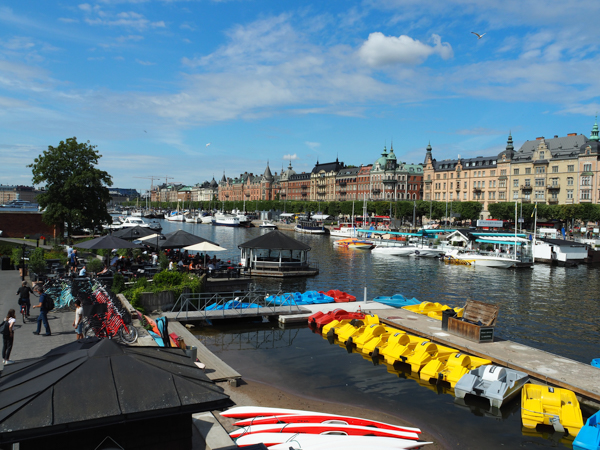
Our overnight flight landed in Stockholm in the early morning. We've learned that the best antidote for jet lag is to be active and in the sunlight. Even though our room was ready, we hit the pavement.
There had been two excursion options for the following day. We chose an out-of-town excursion, so we planned to pursue the downtown offerings on our own. We debated whether to start with Gamla stan, the old town just across the bridge from our hotel, or the Vasa Museum on a different island a bit farther away. The young woman who met us at the airport said that the Vasa Museum was only about a 15 minute walk, so we decided to start there. HA! It was about an hour! And the general admission line at the museum was too long to be appealing.
Never mind, it was good exercise and met the requirement of getting out. We walked almost the entire length of Strandvägen to reach the island Djurgården where the Vasa Museum and other historical sites are located.
We were pleased that there is a free ferry to return us to downtown!
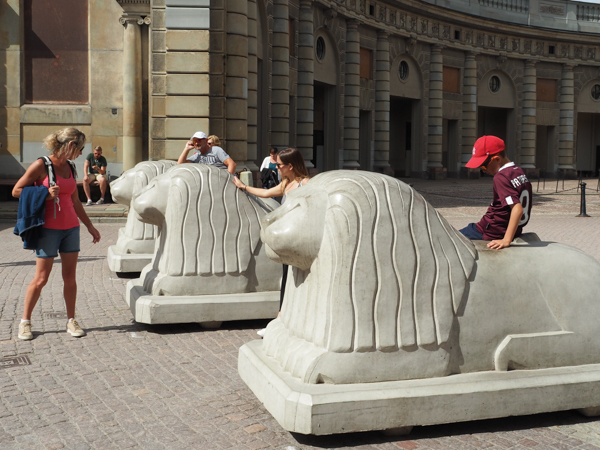
By now we were dragging, but after lunch we soldiered on and took a short walk around Gamla stan. One of the many things we didn't know about Stockholm is that it is situated on many islands.
The old town was crowded and we were tired. We didn't try to visit the various government buildings and had no interest in shopping.
What attracted me most were the numerous concrete lions at strategic locations throughout the old town. These were put into place after a terrorist ran a hijacked truck into a crowd. They protect areas where people gather. So much more attractive than Jersey barriers! The lion is an important element in Swedish heraldry and we saw many representations throughout our time in Sweden.
We saw similar barriers in many of the cities we visited -- each with its own theme. Most of them attracted children or footsore adults.
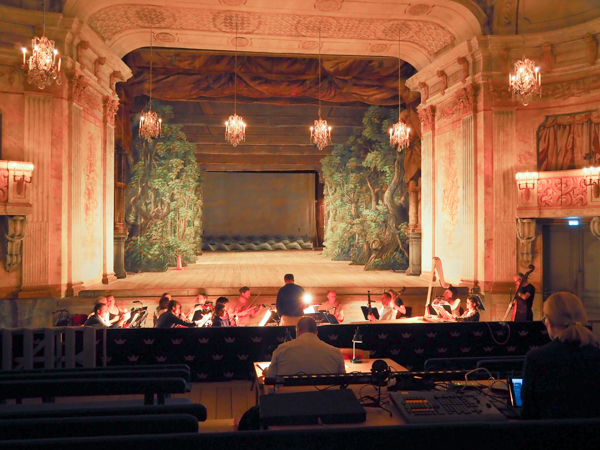
The following day we boarded buses to travel to Drottningholm Palace. Drottning is Swedish for Queen and the palace was commissioned in 1576 as a gift for queen Katarina Jagellonica. After various ups and downs, today the palace is the official residence of the royal family, but the gardens and state rooms are open for tourists.
The primary attraction for us was the palace theatre. The current building dates from the mid-18th century. At the time of its construction, the Swedish royals were strapped for cash, so many innovative cost-saving techniques were used. It fell into disuse at the end of the 18th century so its workings were never "improved." It is now one of the few complete Baroque theatres with original stage machinery.
We listened to the orchestra rehearse. They used Baroque instruments to keep with the theme of the space. Having some (very) limited orchestral experience myself, I was interested that the conductor worked with the musicians on interpretation rather than dictating his own ideas.
The theatre maintains an active performance schedule and tickets may be purchased at the gift shop.
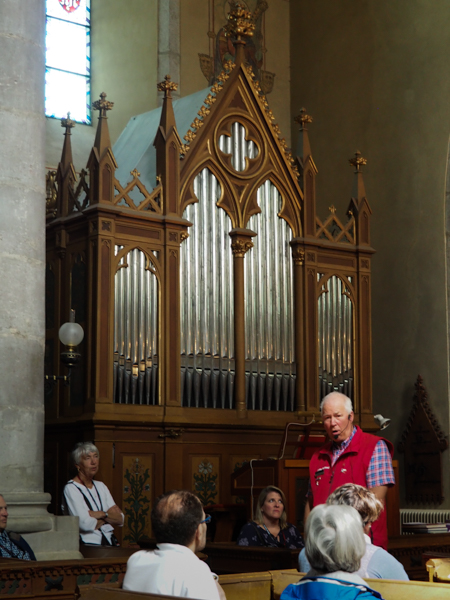
We boarded our ship that afternoon. Jim and I were pleased to confirm that the ship, now the Hebridean Sky, is in fact our old friend the Corinthian II. We took this ship across the South Atlantic in 2010. It has gone through several names and ownerships since then. Although the Baltic Sea was calm to the point of glassiness, we assured our fellow travelers that the ship could take a lickin' and keep on tickin'.
Our first port of call was Gotland. We had chosen the countryside excursion rather than the Visby tour. It started with the medieval church in Dalhem. There were other stops but this was the most notable.
Our tour guide (in the red vest) had a magnificent voice and the church's acoustics were fabulous. He sang three local folksongs.
The rest of the tour was only OK. We regretted not seeing Visby, but his singing made up for a lot!
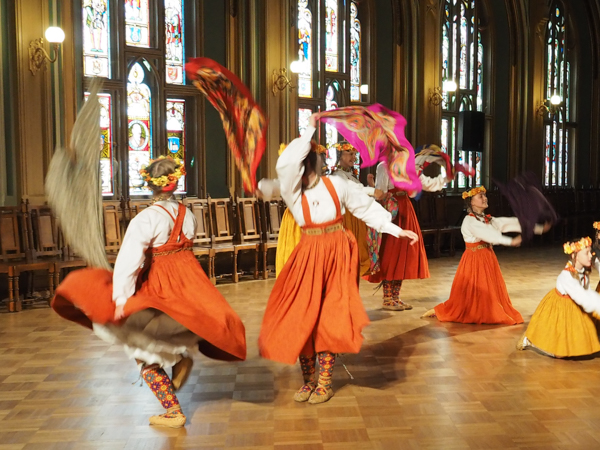
Our stop in Riga featured a performance by a children's dance troupe named "Dzintarins." I couldn't find any English-language information about them on the WWW, but the troupe has been in existence since 1953.
These youngsters, who range in age from 3 to teenagers, were exceptional. I took about 100 pictures and was hard put to narrow it down to just a few.
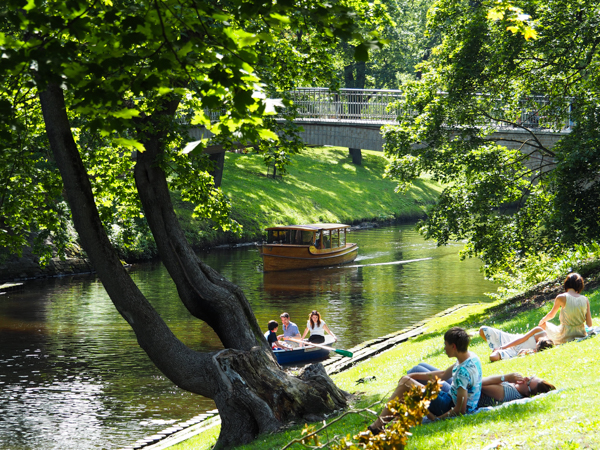
Of all the places we visited, Riga was the only one that didn't seem totally focused on tourists. Often we would find four or more mega-cruise-ships with 1000s of passengers at our ports of call (see below), but on the day we visited Riga we were the only ship. Riga's port facilities in general were extensive and thoroughly modern.
In addition to our guided tours, I enjoyed spending an hour or so just hanging out by the City Canal with the locals. Of the places we visited, this is the one where I would like to spend more time.
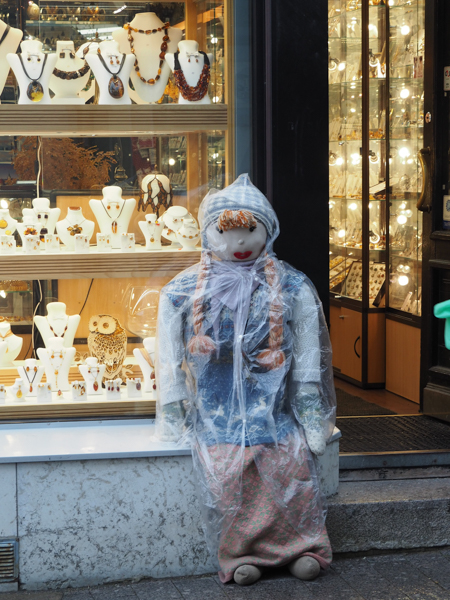
Tallinn was an example of a place that was overrun. There were at least four large ships there on the same day including Silver Spirit (500+ passengers), Seabourn Ovation (600+ passengers), Mein Schiff 4 (2,700+ passengers) & AIDA Prima (3,000+ passengers). This in addition to the large ferries that came and went throughout the day. That's 7,000+ passengers, give or take. EVERYTHING was crowded!
Plus it rained most of the day.
I was amused by this little "greeter" outside an amber shop. She was dressed for the weather.
That said, it was an interesting place and the favorite of many in our group. It was a major player in the medieval Hanseatic League. The old city was divided in two: the upper part, which was occupied by the local nobility, and the lower part, where the merchants lived. The two groups distrusted each other and had locked gates at night.
The city has the distinction of never having been destroyed in war.
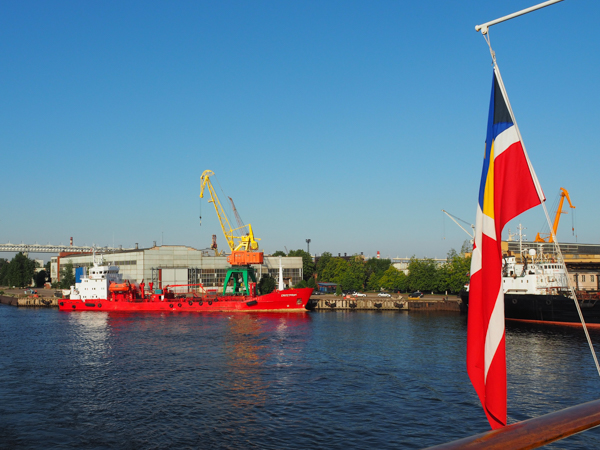
St. Petersburg takes up a disproportionate amount of this overview because we spent two days and saw so much while there.
The Hebridean Sky is small enough that it isn't consigned to the out-of-town cruise port. We passed through the canals and rivers into the heart of the city.
There was no opportunity for free time in St. Petersburg since all the passengers were covered by a group visa. We had to show proof that we were with a tour group and had to be accompanied by a guide at all times.
We were amused that officials checked our papers carefully for our first excursion and then barely examined them for all subsequent ones.
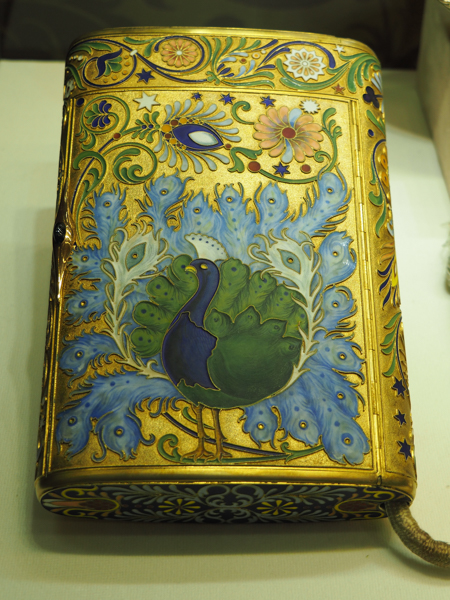
Our first tour was of the Fabergé Museum housed in the Shuvalov Palace. It featured many of the famous eggs made for the Romanov family, but I found this enameled case appealing. Since we were traveling with a guide who had a prescribed path to follow, I didn't get to check out the description sheets to find out more about it. Apparently it wasn't fabulous enough to make the guide's list.
This museum has nine of the Imperial eggs. The Richmond, VA, Museum of Fine Arts has five! The Hillwood Estate in DC has two. Therefore I've now seen a bit over one-third of the surviving eggs!
In addition to eggs, there were many other beautiful exhibits and the palace itself is stunning.
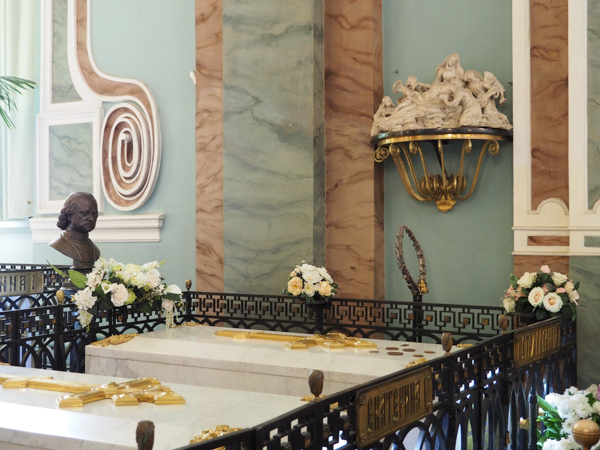
After touring the museum we boarded a boat to cruise through the St. Petersburg canals and cross the Neva River to the Peter and Paul Fortress, the initial settlement in the area.
The Peter and Paul Cathedral is fabulous, but my goal was Peter the Great's tomb. When we visited Russia five years ago, much of our reading was focused on him and both Jim and I were captivated.
Most of the Romanov tsars and their families are buried here, including the remains of the last tsar, Nicholas II.
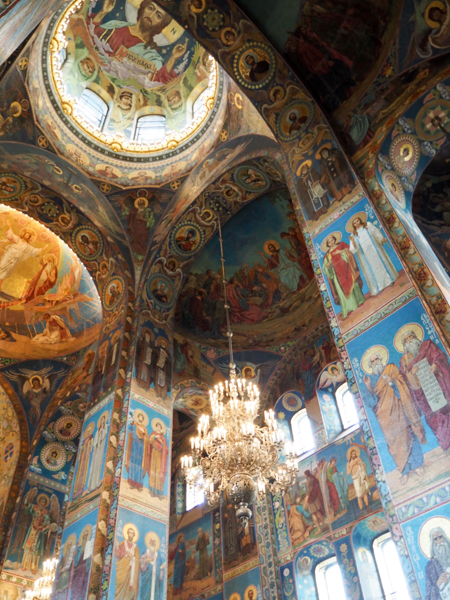
We had been delighted to see that we would visit the Church of the Savior on Spilled Blood. During our last visit we had only seen the exterior of the church. The interior mosaics are breathtaking.
The "spilled blood" was that of Tsar Alexander II, who was murdered by an anarchist's bomb on this spot.
Like many of the attractions we visited, it was very crowded. Since we had timed tickets for the group, at least we didn't have to wait in line.
On our last trip we were told that the aggressively "Russian" style of the church, which stands out in Baroque and Neo-Classical St. Petersburg, was deliberately chosen by Alexander III to signal increased conservatism. His father, in contrast, had been relatively progressive.
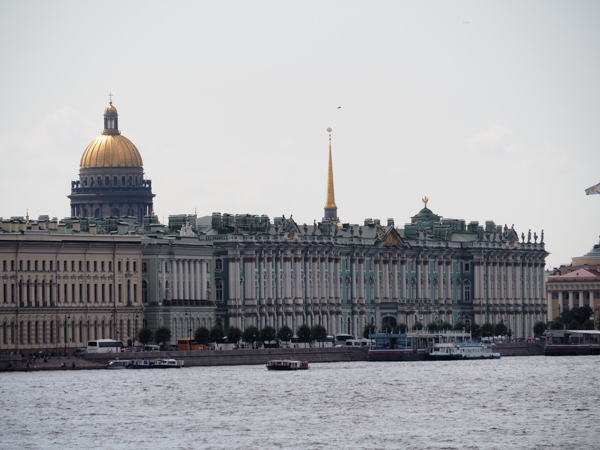
The Winter Palace, located on the banks of the Neva River, now houses the Hermitage art collection. We were privileged to have a private (yes, private!) after hours tour.
The colonnaded portion to the right is the Winter Palace proper, the fourth iteration.
Next to it is the Small Hermitage, built by Catherine the Great.
Continuing to the left, the facade is of the Old or Great Hermitage. It is in front of the New Hermitage.
Not visible in this image is the original Winter Palace of Peter the Great. It now houses the Hermitage Theatre. This was the only building we did not tour as there was a production scheduled.
The dome in the background is St. Isaacs Cathedral. The spire is the Admiralty. Neither has any association with the Winter Palace.
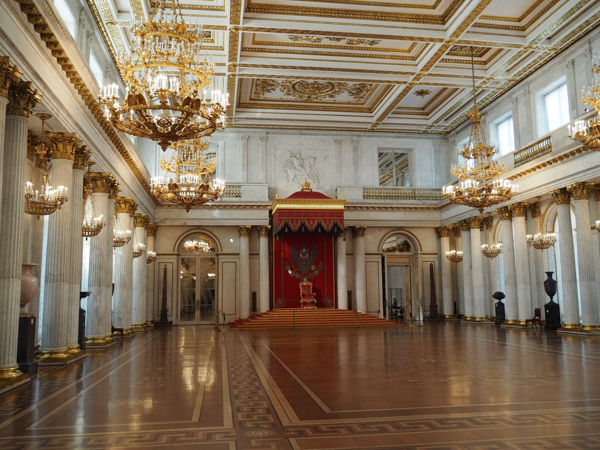
St. George's Hall is one of the more restrained reception rooms in the Hermitage.
The tsar sat on the uncomfortable-looking throne under the canopy. Above is a bas relief of St. George slaying the dragon, hence the name.
Our private tour allowed many (too many) pictures of the great halls without people in them.
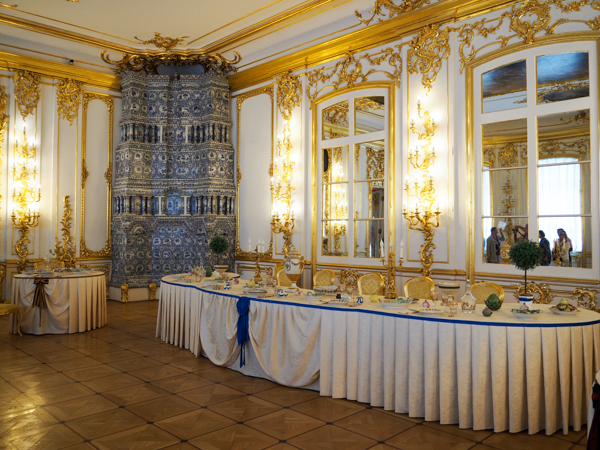
Our second day in St. Petersburg we had the choice of a tour to the Catherine Palace or Peterhof. Since we had seen the latter on our first trip, we chose the Catherine Palace. It is located in a small town on one of the few spots of high ground in the St. Petersburg area. The town is now called Pushkin Village after the great poet, but for most of its life it was Tsarskoe Selo or Tsar's Village.
Pictures of the exterior may be seen at the link. This is one of the dining rooms used by Catherine the Great. There were several. As I recall we were told that she sat at the small table to the left.
The large blue & white structure is a stove used to heat the room. All of the state rooms had similar massive stoves.
According to online sources, this is the Chevaliers' Dining Room.
The palace was almost totally destroyed by the Nazis during the siege of Leningrad. Retreating soldiers left a bomb to finish the structure off, but it failed to detonate. The Germans removed the priceless paneling in the Amber Room and it has since disappeared. The palace currently has a reproduction.
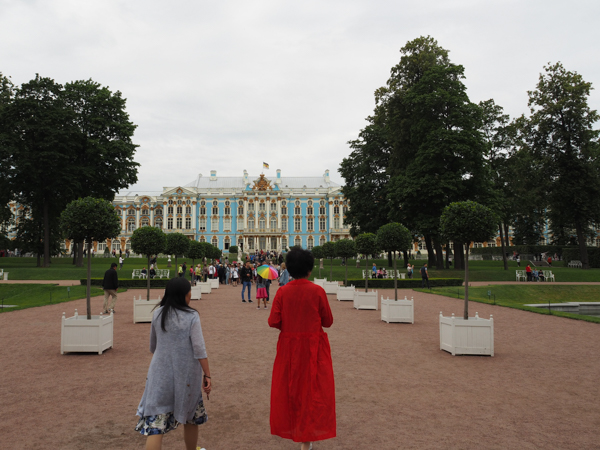
The palace as seen from the garden.
There were several gardens but we didn't have time to visit them. Catherine's hold on power was tenuous and she didn't dare leave Russia lest supporters of her son seize control. She had the gardens of the world brought to her! This palace featured a formal French garden and an English-style landscape garden. There was a lake surrounded by "villages" of various styles.
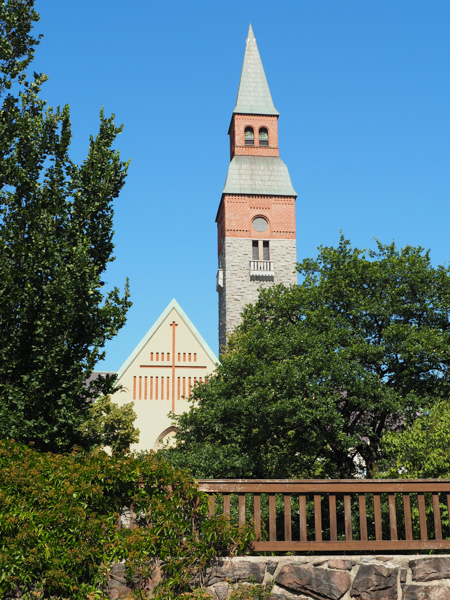
By the next morning we were in Helsinki.
The high point of our morning tour was the National Museum of Finland. We only had time for a cursory review of the exhibits, but the building itself was a major attraction. It was designed by Eliel Saarinen, father of Eero Saarinen, designer of Dulles Airport and other works.
We had a free afternoon in Helsinki and I was glad to get out on my own and WALK! Slow sauntering and standing around listening to a guide was aggravating.
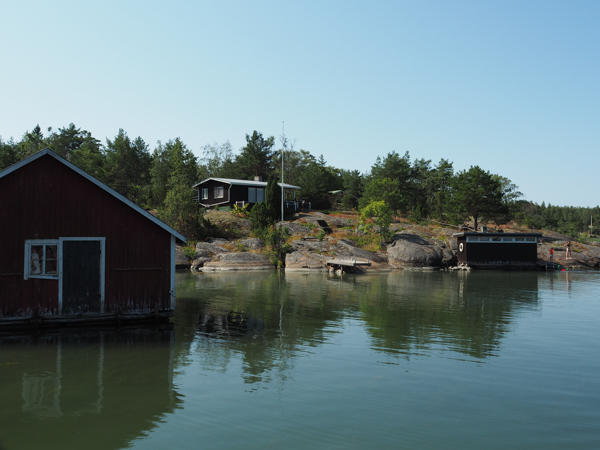
I was to get even more exercise the following day at the Åland Islands. Jim signed up for a tasting of "local spirits," and I signed up for a bicycle excursion. He enjoyed his choice very much. I hadn't ridden a bike in many years and struggled. The bikes were heavy and awkward. They were equipped with both hand brakes, which is what I have always used, AND coaster brakes, which I have never used! Additionally my friends told me that the rear tire was almost flat.
All of that added up to an embarrassing morning in which I managed to fall three (3) times. The coaster brakes were my nemesis as I habitually rotate the pedals backwards before stopping and putting my foot down. That invariably brought the heavy bike to an unexpectedly abrupt halt and I lost my balance. The weight of the bike added to the flattish tire gave a good workout on even the slightest hill.
Ah well, the islands were beautiful and it was a great day to be out.
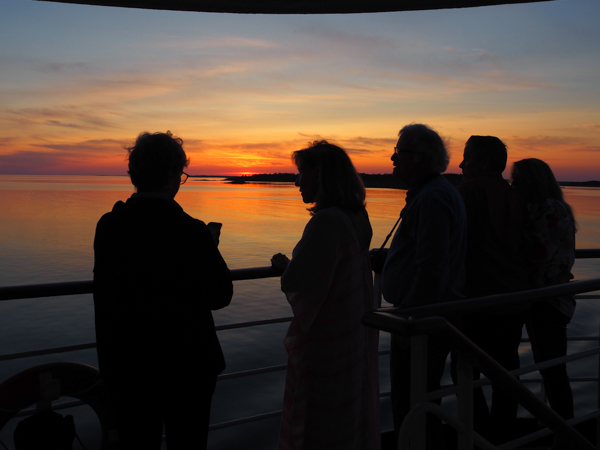
After the morning excursion it was time to pack and get ready to return home. We really enjoyed the whirlwind tour and the company of our fellow travellers. The lectures gave us a good foundation for understanding the contribution of this area to world history and how it might contribute in the future.
Click your "back" button to return to the previous page or click for our picture album.